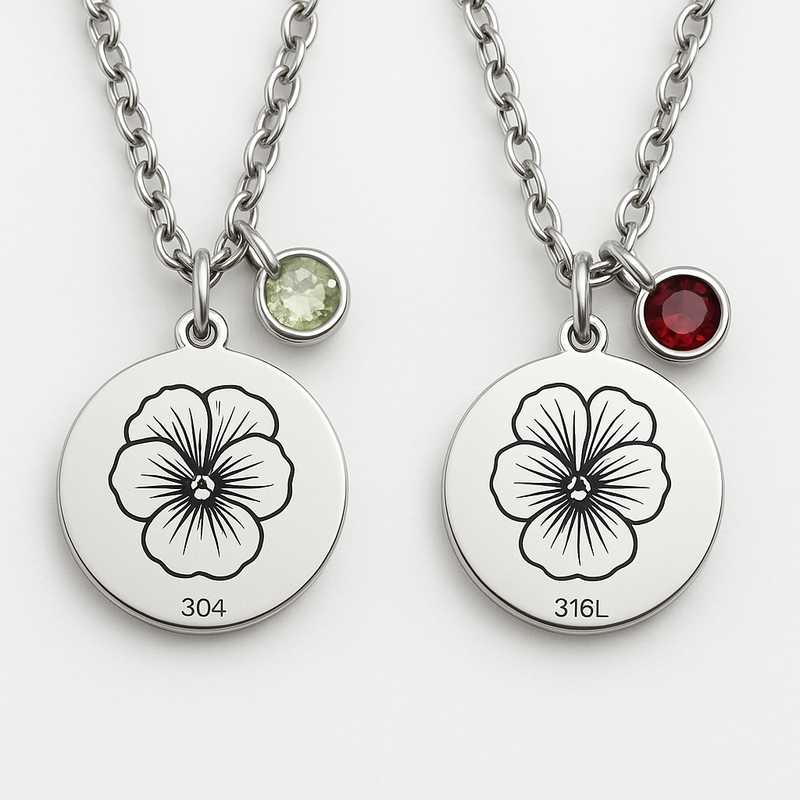Precision & Sustainability: The New Standard in Birthstone Jewelry

Explore stainless steel tech in custom charm necklaces—304 vs 316L, green plating, laser cutting & more for OEM/ODM excellence
In the evolving landscape of stainless steel jewelry manufacturing, innovation isn’t just a competitive edge—it’s the foundation for sustainable growth. Today’s B2B clients in the OEM/ODM sector seek more than aesthetics; they demand high-performance materials, eco-conscious processes, and precision craftsmanship. That’s where our birth month flower birthstone charm necklaces shine—crafted with advanced stainless steel technology, powered by 304 and 316L grades, and enhanced with green plating, laser micro-fabrication, and zero-waste workflows.
This special feature dives deep into the technical backbone of our manufacturing: a world where material science meets sustainable engineering, transforming simple charms into high-value, long-lasting jewelry ready for global markets. Let’s explore how precision and sustainability are redefining the standards in stainless steel custom jewelry production.
304 vs 316L Stainless Steel: Performance in Real-World Jewelry Applications
Understanding the distinction between 304 and 316L stainless steel is essential for OEM/ODM clients prioritizing durability, skin safety, and resistance to harsh environments.
Corrosion Resistance Comparison
- 304 Stainless Steel: Contains 18% chromium and 8% nickel. Excellent corrosion resistance for general indoor wear and mild outdoor exposure. Cost-effective and widely used in decorative jewelry components.
- 316L Stainless Steel: Includes 2-3% molybdenum, significantly boosting resistance to chlorides, sweat, and saltwater. It’s hypoallergenic, tarnish-resistant, and ideal for long-wear charms and bracelets exposed to skin oils, lotions, or sea air.
Application Scenarios
- 304 Steel: Recommended for large batch runs of seasonal pieces or charms designed for occasional use. Ideal for gifting series and limited collections.
- 316L Steel: The gold standard for premium, everyday-wear birthstone necklaces. Excellent for export to tropical climates or high-humidity regions, such as Southeast Asia or coastal U.S. markets.
By offering both 304 and 316L options, OEM/ODM clients can target multiple price tiers while ensuring performance consistency tailored to end-user environments.
Laser Cutting & Hydraulic Stamping: Crafting Charm Necklaces with Precision
In custom stainless steel jewelry, micro-level precision directly impacts visual detail and tactile quality. We leverage both laser cutting and hydraulic stamping to push the boundaries of charm manufacturing.
Laser Cutting Technology
We use fiber lasers with precision up to ±0.01 mm, enabling us to craft ultra-fine floral motifs and gemstone bezels without tool wear. This process supports intricate layering, custom cutouts, and edge polishing in a single step. Laser-cut birth month flower patterns (e.g., March’s daffodil or December’s narcissus) maintain crisp definition even at 1mm thickness.
Hydraulic Processes
For embossed texture or 3D sculpting, hydraulic presses generate uniform pressure up to 250 tons. This is especially useful for multi-surface stamping on thicker charms (2–3mm), allowing both front-facing engraving and backplate logo marks. Repeatability ensures each batch matches brand spec standards perfectly.
Combined Process Example: A May emerald charm set might start with laser outline cutting, proceed to hydraulic flower embossing, and finish with laser-engraved SKU codes—all automated in-line.
Corrosion Pattern Testing & Finish Retention: Scientific Methods in Aesthetic Durability
Beyond material choice, we conduct controlled tests to simulate real-world wear and maximize the lifespan of plating and patterns.
Corrosion Patterning Simulations
- Salt spray chambers: Simulate 2–5 years of environmental exposure in 96 hours, revealing edge-based vulnerabilities or pit formation under plating.
- Acid/base immersion: Validates performance of green plating in household chemical scenarios (e.g., perfume, detergents).
Retention Metrics
- Color-fade rates post-immersion are less than 2.5% over 50 cycles.
- Gloss retention on vacuum-plated gold layers remains at 92% after 800 abrasive brush strokes (dry test).
This scientific, quantifiable data allows clients to confidently pitch “long-lasting” to their buyers—backed by real metrics, not just visual appeal.
Green Electroplating & Zero-Waste Manufacturing: Sustainable Excellence in Practice
Today’s B2B buyers are increasingly eco-conscious, and compliance standards (like REACH, RoHS) are a necessity. Our stainless steel jewelry production integrates multiple environmentally friendly technologies to meet this demand.
Eco-Conscious Plating Technology
- Trivalent Chromium: Replaces toxic hexavalent chromium for hypoallergenic silver and rhodium finishes.
- Electroplating Recovery Loops: Closed-loop systems collect and reuse over 85% of residual metals in bath solutions, reducing environmental impact and operating cost.
- Low-VOC Organic Dyes: For rose gold and color-enhanced plating, we use eco-certified alternatives to traditional chemical pigments.
Waste Management & Water Filtration
- All rinse waters pass through 4-stage filtration and activated carbon beds before release.
- Solid metal shavings from CNC and laser processes are collected and remelted for reuse in mold testing and prototyping.
These practices aren’t marketing fluff—they are verifiable, cost-saving, and regulation-compliant strategies built into every batch of jewelry we export.
Case Study: Birthstone Floral Charm Line for Premium European Retail Chain
Let’s see how all these technologies and materials come together in a real-world OEM project.
Client: Boutique retail chain with over 150 stores across Germany, Austria, and Switzerland.
Product: 12-piece birth month floral charm collection featuring stone-set flowers (e.g., sapphire + aster for September).
Process Highlights
- Material Selection: 316L stainless steel used to meet nickel-free and salt-sweat resistance requirements under EU standards.
- Production: Laser engraving + hydraulic bloom pattern embossing, vacuum gold plating with trivalent chromium for hypoallergenic finish.
- Green Practices: Tracked 91% material recovery rate, zero plating bath discharge, and 100% paper-based eco packaging.
Results: Product defect rate stayed under 0.4% over 3 production runs. Delivered ahead of schedule. End client reported 23% higher sell-through rate compared to their previous charm collection.
Conclusion: Raising the Bar in Custom Stainless Steel Jewelry
In today’s competitive OEM/ODM jewelry market, success lies in combining high-quality materials, advanced manufacturing techniques, and sustainable processes. With smart material choices like 316L stainless steel, laser and hydraulic tooling, and low-impact green plating systems, we ensure every charm necklace isn’t just beautiful—it’s reliable, ethical, and scalable.
Ready to bring your next stainless steel jewelry line to life? Let’s talk prototypes, sampling, and scalable batch production tailored for your market. Contact us today to learn how precision and sustainability can be the new cornerstones of your brand.
